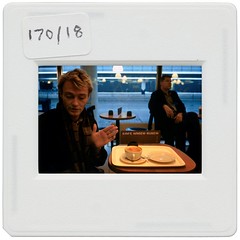In my teens I took snapshots, as everybody does. Like all such images, they were of no interest to anyone but the subjects. I neither knew nor cared about niceties such as composition and correct exposure. For reasons that are now unclear to me, I took fewer and fewer such photographs after I left home in 1988. The very last roll of film that I began innocently, with the purity of heart that a true snapshot requires, dates from early 2000. I lost the camera before I finished it.
As a replacement, I bought one of the newfangled digital cameras – I think it had one megapixel – but it seemed too easy, too banal, so I traded it in for a second-hand Polaroid Spectra. After that, I steadily ‘regressed’ through the history of photography, beginning with a manual 35mm SLR, followed by an even older Rolleiflex, and finally a large-format bellows camera.
Nostalgia does not interest me, so I avoided photographing anything obviously related to my personal life. I also worked at night with a tripod. I wanted to slow things down, to make everything more laborious and more self-conscious. I wanted images that were the exact opposite of everything implied by the word ‘snapshot’. Some of these photographs can be found at
www.letusburnthegondolas.com.
At the end of 2003, I was preparing for my first visit back to Europe after moving to Australia a year before. This global tour seemed a good opportunity to review my relationships with the people and places that mattered to me. With this theme in mind, I decided to take a series of 35mm colour slides. Again the choice of an obsolete format had nothing to do with nostalgia. Rather, it is no longer a ‘natural’ or obvious choice, so it cannot be taken for granted
What, then, are the specific properties of a 35mm slide? Like a Polaroid, it is a unique, positive image. Its creation neither requires nor permits any intervention from the photographer beyond the initial moment of exposure, and it records colour ‘objectively’. Unlike the eye, it cannot compensate for the cast of artificial light, and unlike a print from a negative, it transmits rather than reflects light. Finally, its speed is relatively slow, and its exposure range is narrow.
Traditionally, the goal with a large-format camera is to produce a hand-crafted, black-and-white print: monumental in both subject and scale. Not only does the photographer adopt a patient, meditative, awe-struck attitude, but he implicitly demands the same attitude of the viewer. Each image makes the same claim, separately.
By contrast, here we have a sequence of seemingly-casual images whose technical limitations are often glaringly obvious and which – in their original format – are experienced in succession for a few seconds as an intangible projection on a wall or screen. They no sooner arrive than they are gone. Under these circumstances, it is impossible to remember every detail.
I was looking for a balance between two opposed states of mind: dislocation and intimacy. Since this balance is a delicate one, I tried not to disturb it by thinking too much about any shot. Nor did I repeat any that failed. I did not plan, and I did not direct or solicit responses. Many of the images were shot at night or in poor interior light – all without flash. They are literally fleeting in that they are obscured by grain, deep shadows and a minimal area of focus.
It is easy to take slides in which everything is blurred. It is almost as easy to take slides in which everything is in focus. What is difficult is to make photographs that lie on the thin line between order and chaos. To put it another way, while some of these images were taken in the cold light of day, the most representative are trying to capture the precise moment when ‘not drunk enough’ is about to tip over into ‘too drunk’. In reality, that moment is anything but precise: it is as impossible to isolate as the moment when you fall asleep. But it can be identified in a photograph – if only retrospectively.
[The text above can also be found
here. The slides from
I Am a Pilgrim will be posted here in pairs in successive entries over the next six days.]





